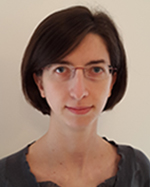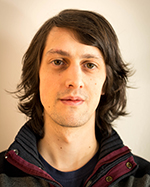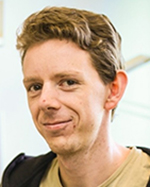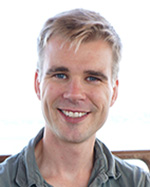Tidligere arrangementer - Side 14
M.Sc. Siv Gundrosen Aalbergsjø ved Fysisk institutt avholder prøveforelesning over oppgitt emne: "The accuracy of DFT for determining EPR parameters of transition-metal systems: pros and cons with DFT, and possible alternatives"
Master of Electrical Engineering Naveen Goud Ganagona ved Fysisk institutt avholder prøveforelesning over oppgitt emne: "Metamaterials;- Background, manufacturing, properties and applications".
Kai Schmidt Hoberg, DESY, Hamburg [slides]
I will review motivations for the existence of self interacting dark matter and discuss possible astrophysical observables. Self-interactions of dark matter particles can potentially lead to an observable separation between the dark matter halo and the stars of a galaxy moving through a region of large dark matter density. Such a separation has recently been observed in a galaxy falling into the core of the galaxy cluster Abell 3827. I discuss the DM self-interaction cross section needed to reproduce the observed effects.
The research centre for dark matter, The Strategic Dark Matter Initiative - SDI, will officially be launched on Friday, and invites you all to a popular science lecture, with coffee and snacks.
Thomas Jacques, Université de Genève, Switzerland [slides]
As beyond-standard-model physics continues to elude discovery at the LHC, it becomes increasingly important to ask what we can learn about dark matter in a model-independent way. I will introduce the theory and usage of effective operators; these have become popular in recent years as a way to construct model-independent constraints on dark matter, but at LHC energies it is crucial to understand their significance and limitations, and how they can be used to compare the reach of vastly different experiments. With this in mind, I will also discuss the next step beyond effective operators, and techniques to link the search for missing energy with the much-sought-after Dark Matter.
Mark Burgess
Physics is probably the most successful science when it comes to describing how things behave, but it avoids interpreting the meaning or the intent of behaviours. In technology, especially IT, meaning and intent are at the top of the list when it comes to description, but IT fails to describe system dynamics convincingly. Promise Theory is an attempt to unify dynamical and semantic descriptions of systems, inspired by the successes of physics - and it sheds an interesting light on both fundamental physics and information science.
Laurea in Scienze Fisiche Beatrice Mandelli ved Fysisk institutt vil forsvare sin avhandling for graden ph.d: "Detector and System Developments for LHC Detector Upgrades"
Laurea in Scienze Fisiche Beatrice Mandelli ved Fysisk institutt avholder prøveforelesning over oppgitt emne: "Probing the unknown at LHC: Beyond Standard Model Physics" .
Master of Science Magnar Kopangen Bugge ved Fysisk institutt vil forsvare sin avhandling for graden ph.d: "Search for new charged bosons and dark matter in final states with one lepton and missing transverse energy with the ATLAS detector at the LHC"
Master of Science Magnar Kopangen Bugge ved Fysisk institutt avholder prøveforelesning over oppgitt emne: "Neutrino mass and mixing: what do we know today and what are the open questions?"
Thomas Schwetz-Mangold, Stockholms Universitet [slides]
The observation of neutrino oscillations requires that neutrinos have a tiny but non-zero mass. This implies that the Standard Model of particle physics has to be extended in some way beyond its original formulation where neutrinos are massless. We review the present status of neutrino oscillations and give a brief outlook on future developments in the field. We speculate on the implications for physics beyond the Standard Model and discuss the challenges to identify the mechanism responsible for neutrino mass.
Nils-Erik Bomark, University of Warsaw
Within the MSSM, the heavy stops required to meet the experimental value of the Higgs mass, poses tension with naturalness, the main reason to believe in supersymmetry at LHC scales. This is alleviated in the NMSSM, where especially the possibility of a light singlet-like scalar can easily push the Higgs mass up to the measure value.
The presence of a singlet-like scalar and pseudoscalar gives rise to LHC phenomenology potentially rather different from the MSSM as these particles can be very light without coming in conflict with observations. In this presentation I will discuss the discovery prospects of these light pseudoscalars in the NMSSM. As direct production of such singlet-dominated particles is very difficult, the main focus will be on channels where heavier scalars decay to pairs of pseudoscalars or pseusodscalars and Z bosons. I will demonstrate that the LHC should be capable of probing a large part of the NMSSM parameter space through these channels.
Carmelo Evoli, Universität Hamburg [slides]
At GeV-TeV energies the propagation of CRs in our Galaxy is diffusive. Current models of galactic propagation are based on a simplified approach for which diffusion is constant and isotropic. In fact, diffusion transport must be described as in-homogenous and anisotropic and experimental data have now reached an accuracy that allows to study such effects.
In my talk, I will present some of the consequences of adopting realistic diffusion models for the propagation of galactic CRs, and I will show how these models allow a better understanding of local observations and diffusion emissions within an unified framework.
In the second part of my talk, I will focus on antiprotons as a tool to set constraints on DM models. In particular, I will discuss the uncertainties associated to both standard astrophysical and DM originated antiprotons. I will show on which extent current antiproton data can place tight constraints on DM models, excluding some of those suggested in connection with indirect and direct searches.
Marco Cirelli, Saclay, France [slides]
The field of Dark Matter Indirect Detection is in a thriving but somewhat chaotic moment: quite a few hints of possible detection of signals of DM (over a large range of masses and, in general, inferred properties) are confronted with stringent constraints, often based on the same experiments that provide the possible hints. In turn, this spurs a lot of theoretical activity, aimed at phenomenologically analyzing the claims and, perhaps, at embedding them in wider model building. I will briefly review the current status of the searches, mention the most debated hints and sketch the general directions of the theory activity.
Master of Science Per Harald Ninive ved Fysisk institutt vil forsvare sin avhandling for graden ph.d: "Towards a complete description of aluminium from atomistic modeling – A parameter-free study of hardening precipitates in Al alloys"
Master of Science Per Harald Ninive ved Fysisk institutt avholder prøveforelesning over oppgitt emne: "Effect of Mg-Si precipitates on mechanical behavior in Al 6xxx alloys" .
Daniele Gaggero, SISSA, Trieste, Italy [slides]
In the first part of the talk, after a general introduction on the physics of cosmic rays (CRs), I present a detailed overview on recent results regarding modeling of CR propagation in the Galaxy and in the Heliosphere. In particular I focus on the necessity to go beyond the standard and simplified picture of uniform and homogeneous diffusion, showing that gamma-ray data point towards different propagation regimes in different regions of the Galaxy. I also sketch the impact of large-scale structure on CR observables. Concerning the propagation of the Heliosphere, I mention the necessity to consider a charge-dependent modulation scenario.
In the second part, I discuss several aspects of the recent claim of a gamma-ray excess in the Galactic center region, discussing in particular the interpretation in terms of Dark Matter, compared to other astrophysical interpretations. I will emphasize the interplay between the non-trivial aspects of CR propagation discussed in the first part and the understanding of the GC excess origin. In particular, I will show in detail how the knowledge of the CR transport parameters and solar modulation is crucial to investigate the compatibility with other channels (namely antiprotons) and to provide alternative astrophysical interpretations.
Susanne Viefers, UiO
In recent years there has been substantial interest in the study of strongly correlated states of cold atoms, analogous to exotic states known from low-dimensional electron systems - one 'holy grail' being experimental realisation of quantum Hall-like states in atomic Bose condensates. In particular there have been many studies on the rotational properties of cold atom systems, as rotation is the conceptually simplest way of simulating a magnetic field for electrically neutral atoms. Even richer physics is expected in the case of two-species gases, such as mixtures of two types of bosonic atoms.
In this talk I will give an introduction to the field, followed by some recent results on the rotational properties of two-species Bose gases in the lowest Landau level. In particular we show that, contrary to expectations, trial wave functions of the composite fermion (CF) type, known from quantum Hall physics, give a very accurate description of this system. It is also shown how working only with a certain subset of possible CF candidate wave functions constitutes a major computational simplification without much loss of accuracy for the low-lying states. Finally I will briefly discuss some striking mathematical identities between seemingly different CF candidate states, of interest for a better understanding of the CF method in general.
Each year in spring, research institutes and universities around the world invite high-school students for a day-long programme to experience life at the forefront of basic research. These International Masterclasses give students the opportunity to be particle physicists for a day by analysing real data from the Large Hadron Collider, or LHC, at CERN.
Abram Krislock, UiO
During Supersymmetry phenomenology research, involving simulations of the Large Hadron Collider experiments, a certain mistrust of data analysis using common histograms arose. Someone once said, "Change the bins and try the fit again..." A quest began to eliminate the bins entirely. After a recent study, it was clear that a deeper understanding of statistics was needed to complete this quest. A new probability calculus was discovered, leading to an interesting new data smoothing technique.
Each year in spring, research institutes and universities around the world invite high-school students for a day-long programme to experience life at the forefront of basic research. These International Masterclasses give students the opportunity to be particle physicists for a day by analysing real data from the Large Hadron Collider, or LHC, at CERN.
Carsten Lütken, UiO
The new states of matter and concomitant quantum critical phenomena revealed by the quantum Hall effect appear to be accompanied by an emergent modular symmetry. The extreme rigidity of this infinite symmetry makes it easy to falsify, but two decades of experiments have failed to do so, and the predicted location of quantum critical points is in accurate agreement with experiments.
The symmetry severely constrains the effective low energy physics of 1010 charges in two dirty dimensions. A toroidal σ‐model gives a critical exponent that is in close agreement with numerical simulations. A double scaling law uncovered in the data suggests that the wave‐function may be multi‐fractal.
The modular analysis can be extended to “relativistic” group IV materials like graphene, silicene, germanene and stanene, and where reliable data are available there appears to be agreement.
C.A. Lütken, Introduction to the role of modular symmetries in graphene and other 2-‐dimensional materials, Contemp. Phys. (2014), http://dx.doi.org/10.1080/00107514.2014.949445
C.A. Lütken, G.G. Ross, Quantum critical Hall exponents, Phys. Lett. A 378 (2014) 262–265, http://dx.doi.org/10.1016/j.physleta.2013.11.001
Pasquale Dario Serpico, LAPTh, Univ. de Savoy, CNRS
Despite its remarkable success, the Standard Model (SM) of particle physics does not address key facts revealed by cosmological and astrophysical observations. Until now, no signs of new physics have been discovered in laboratory experiments, leaving unclear what is the path chosen by Nature for the physics beyond the SM (BSM). I will discuss in this talk how indirect signals from Dark Matter (DM) might help us in this challenging "theoretical selection problem", with implications on foundational aspects of BSM physics. I will illustrate this point with possible DM interpretations of recent anomalies in multimessenger observations of energetic radiation of Galactic and extragalactic origin.
M. Sc. ved Fysisk institutt vil forsvare sin avhandling for graden ph.d: “Improved beam extraction for a negative hydrogen ion source for the LHC injector chain upgrade, Linac4”
M. Sc. Øystein Midttun ved Fysisk institutt avholder prøveforelesning over oppgitt emne: "The development and applications of H- sources".




